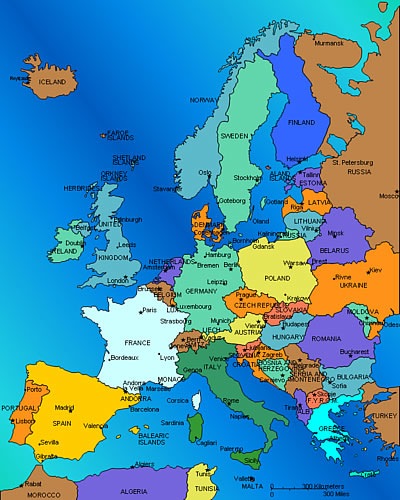Ann Oncol. 2010 Jun;21(6):1323-60. Epub 2009 Nov 30.
Cancer mortality in Europe, 2000-2004, and an overview of trends since 1975.
Department of Epidemiology, Istituto di Ricerche Farmacologiche, Italy.
Abstract
BACKGROUND: To update the pattern of cancer mortality in Europe. Materials and methods: We analysed cancer mortality in 34 European countries during 2000-2004, with an overview of trends in 1975-2004 using data from the World Health Organization. RESULTS: From 1990-1994 to 2000-2004, overall cancer mortality in the European Union declined from 185.2 to 168.0/100 000 (world standard, -9%) in men and from 104.8 to 96.9 (-8%) in women, with larger falls in middle age. Total cancer mortality trends were favourable, though to a variable degree, in all major European countries, including Russia, but not in Romania. The major determinants of these favourable trends were the decline of lung (-16%) and other tobacco-related cancers in men, together with the persistent falls in gastric cancer, and the recent appreciable falls in colorectal cancer. In women, relevant contributions came from the persistent decline in cervical cancer and the recent falls in breast cancer mortality, particularly in northern and western Europe. Favourable trends were also observed for testicular cancer, Hodgkin lymphomas, leukaemias, and other neoplasms amenable to treatment, though the reductions were still appreciably smaller in eastern Europe. CONCLUSION: This updated analysis of cancer mortality in Europe showed a persistent favourable trend over the last years.
Per gli uomini il calo della mortalita' e' del 9%
per le donne dell'8%
declina negli uomini soprattutto il tumore del polmone , il tumore gastrico e intestinale
nelle donne cala la mortalita' per il tumore della cervice uterina e della mammella
Persistono trend favorevoli per il tumore del testicolo, i linfomi di Hodgkin , le leucemie
questa importante analisi pubblicata su Annals of Oncology di giugno 2010 e' coordinata dai ricercatori del Mario Negri di Milano

per gli Sati uniti l'andamanto e' simile
si veda il lavoro pubblicato on-line il 7 luglio :
CA Cancer J Clin. 2010 Jul 7. [Epub ahead of print]
Cancer Statistics, 2010.
Jemal A, Siegel R, Xu J, Ward E.
Cancer Surveillance, Surveillance and Health Policy Research, American Cancer Society, Atlanta, GA.
Abstract
Each year, the American Cancer Society estimates the number of new cancer cases and deaths expected in the United States in the current year and compiles the most recent data regarding cancer incidence, mortality, and survival based on incidence data from the National Cancer Institute, the Centers for Disease Control and Prevention, and the North American Association of Central Cancer Registries and mortality data from the National Center for Health Statistics. Incidence and death rates are age-standardized to the 2000 US standard million population. A total of 1,529,560 new cancer cases and 569,490 deaths from cancer are projected to occur in the United States in 2010. Overall cancer incidence rates decreased in the most recent time period in both men (1.3% per year from 2000 to 2006) and women (0.5% per year from 1998 to 2006), largely due to decreases in the 3 major cancer sites in men (lung, prostate, and colon and rectum [colorectum]) and 2 major cancer sites in women (breast and colorectum). This decrease occurred in all racial/ethnic groups in both men and women with the exception of American Indian/Alaska Native women, in whom rates were stable. Among men, death rates for all races combined decreased by 21.0% between 1990 and 2006, with decreases in lung, prostate, and colorectal cancer rates accounting for nearly 80% of the total decrease. Among women, overall cancer death rates between 1991 and 2006 decreased by 12.3%, with decreases in breast and colorectal cancer rates accounting for 60% of the total decrease. The reduction in the overall cancer death rates translates to the avoidance of approximately 767,000 deaths from cancer over the 16-year period. This report also examines cancer incidence, mortality, and survival by site, sex, race/ethnicity, geographic area, and calendar year. Although progress has been made in reducing incidence and mortality rates and improving survival, cancer still accounts for more deaths than heart disease in persons younger than 85 years. Further progress can be accelerated by applying existing cancer control knowledge across all segments of the population and by supporting new discoveries in cancer prevention, early detection, and treatment. CA Cancer J Clin 2010. (c) 2010 American Cancer Society, Inc.

:::::: Creato il : 16/07/2010 da Magarotto Roberto :::::: modificato il : 16/07/2010 da Magarotto Roberto ::::::